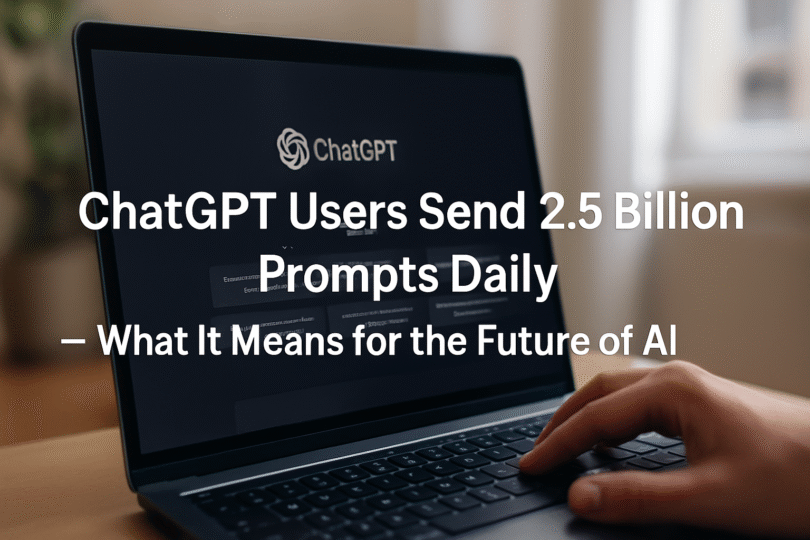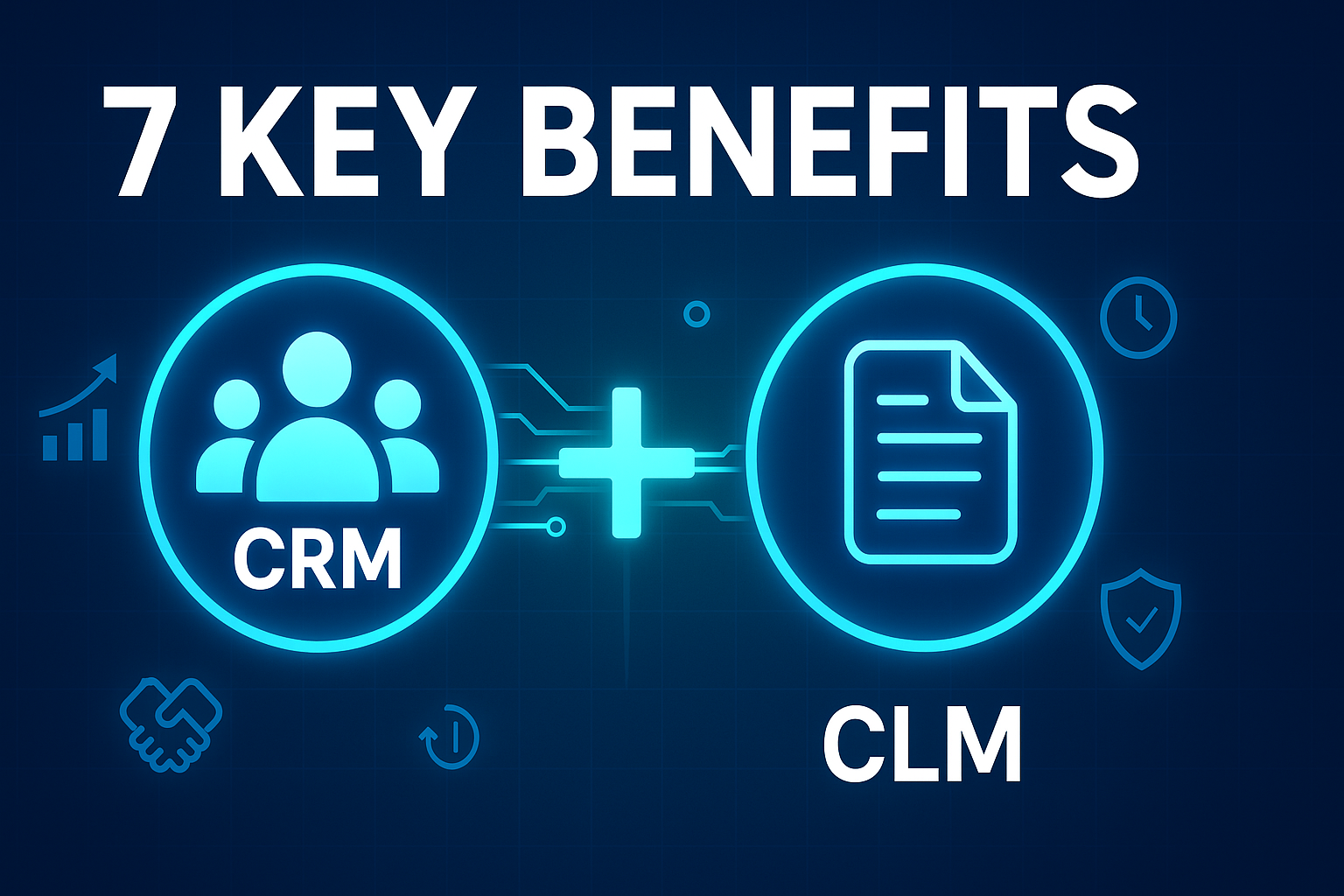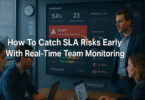Published on July 22nd, 2025
Every single day, 2.5 billion conversations begin with artificial intelligence. That’s the staggering reality of ChatGPT’s current usage, with OpenAI confirming that their flagship AI receives this astronomical number of prompts from users worldwide daily.
To put this in perspective, that’s more than 28,000 prompts every second, around the clock, representing one of the most dramatic shifts in how humans interact with technology in the digital age.
This isn’t just another tech statistic—it’s a window into a fundamental transformation happening in real-time.
When ChatGPT users send 2.5 billion prompts a day, they’re not just asking questions or generating content; they’re collectively redefining the relationship between human intelligence and artificial intelligence.
They’re creating new workflows, solving problems in unprecedented ways, and essentially beta-testing the future of work itself.
The implications stretch far beyond Silicon Valley boardrooms and tech enthusiasts. This massive daily interaction volume signals that we’re witnessing the emergence of AI as an everyday utility, similar to how search engines, email, and social media became indispensable parts of modern life.
But unlike those previous technological shifts, this one is happening at breakneck speed and touching virtually every aspect of human productivity and creativity.
Why 2.5 Billion Prompts a Day Is a Big Deal
The scale of ChatGPT usage statistics reveals something remarkable about technological adoption in the modern era.
While it took Google decades to build up to approximately 13-16 billion daily searches, ChatGPT achieved 2.5 billion daily interactions in less than two years since its public launch. This represents one of the fastest mass adoption rates of any consumer technology in history.
Consider the mathematical reality: with roughly 330 million daily prompts originating from U.S. users alone, that means the average American ChatGPT user is engaging with AI multiple times per day.
The global nature of the remaining 2.17 billion daily prompts demonstrates that AI adoption isn’t limited to tech-savvy early adopters—it’s becoming a worldwide phenomenon that transcends geographical, cultural, and economic boundaries.
What makes this even more significant is the growth trajectory. OpenAI CEO Sam Altman reported over 1 billion daily queries in December, meaning the platform more than doubled its usage in approximately eight months.
This exponential growth curve suggests we’re still in the early phases of AI integration into daily life, not approaching a plateau.
The comparison with traditional search engines illuminates the unique nature of AI interaction. While Google searches are typically brief, transactional queries, ChatGPT prompts represent deeper, more complex engagements.
Users aren’t just seeking information—they’re collaborating with AI to create, analyze, solve problems, and explore ideas. This fundamental difference in interaction depth makes the 2.5 billion figure even more impressive.
The economic implications are equally profound. Each prompt represents a moment where someone chose AI assistance over traditional methods of accomplishing a task.
Whether that’s writing an email, debugging code, brainstorming marketing ideas, or learning a new concept, these billions of daily interactions represent a massive shift in human productivity patterns and economic value creation.
Read More: Is Microsoft Copilot better than ChatGPT?
What Are People Using ChatGPT For?
The diversity of how people use ChatGPT reveals the true breadth of AI’s integration into modern life.
Unlike specialized tools designed for specific tasks, ChatGPT has become a Swiss Army knife of digital assistance, adapting to an enormous range of human needs and professional requirements.
In the professional sphere, content creation represents one of the largest use cases. Marketing professionals are crafting social media posts, email campaigns, and blog outlines.
Business executives are using AI to draft reports, create presentation frameworks, and analyze market trends.
The impact of ChatGPT on work is perhaps most visible in how it’s transformed the writing process itself—from ideation and outlining to editing and refinement.
Software development has experienced a particularly dramatic shift. Programmers are using ChatGPT to debug code, explain complex algorithms, generate boilerplate code, and even architect entire applications.
The AI has become an always-available coding partner that never gets tired of explaining basic concepts or helping troubleshoot frustrating bugs. This has democratized programming knowledge and accelerated development cycles across the industry.
Educational applications showcase another major category of usage. Students are leveraging ChatGPT to understand difficult concepts, practice problem-solving, and receive personalized explanations tailored to their learning style.
Teachers are creating lesson plans, generating quiz questions, and developing creative classroom activities. The AI has essentially become a 24/7 tutor that can adapt to any subject matter or skill level.
Creative professionals have discovered entirely new workflows around AI collaboration. Writers use ChatGPT for brainstorming plot ideas, developing character backstories, and overcoming writer’s block.
Designers leverage it for creative briefs, brand messaging, and conceptual exploration. Musicians and artists are using AI for lyric writing, composition ideas, and creative project planning.
Personal productivity represents another massive usage category. People are using ChatGPT to plan meals, organize travel itineraries, draft personal emails, summarize articles, and manage daily tasks.
The AI has become a personal assistant that’s always available and infinitely patient with seemingly mundane requests.
Small business owners have particularly embraced ChatGPT as a force multiplier.
They’re using it to create business plans, develop marketing strategies, write product descriptions, handle customer service scripts, and analyze competitor positioning.
For entrepreneurs and small teams, AI has become a way to access capabilities that previously required hiring specialists or expensive consultants.
Read More: Best ChatGPT prompts for designers and creatives
Implications for the Future of Work
The 2.5 billion daily prompts represent more than usage statistics—they’re evidence of a fundamental restructuring of how work gets done across virtually every industry.
The impact of ChatGPT on work is creating new job categories while transforming existing ones, leading to a productivity revolution that’s still in its early stages.
Traditional knowledge work is experiencing the most immediate transformation. Tasks that previously required hours of research, writing, and analysis can now be completed in minutes through effective AI collaboration.
This isn’t replacing human intelligence—it’s augmenting it in ways that allow professionals to focus on higher-level strategy, creative problem-solving, and complex decision-making.
The emergence of prompt engineering as a distinct skill set illustrates how new competencies are developing around AI interaction.
Professionals who can effectively communicate with AI, understand its capabilities and limitations, and integrate AI outputs into larger workflows are becoming increasingly valuable.
This represents a new form of digital literacy that’s becoming as important as traditional computer skills.
Marketing and communications fields are seeing particularly dramatic changes. Campaign development, content creation, and audience analysis that once required entire teams can now be prototyped and refined by individuals working with AI.
This is enabling smaller companies to compete with larger organizations in terms of content volume and sophistication.
Research and analysis work is being revolutionized as professionals learn to use AI as a research partner.
Instead of spending hours gathering information, they’re focusing on synthesizing insights, validating AI outputs, and developing strategic recommendations based on AI-assisted analysis.
This shift is making expertise more about interpretation and application rather than information gathering.
Customer service and support functions are evolving as companies integrate AI into their workflows.
Support teams are using ChatGPT to draft responses, troubleshoot complex issues, and create knowledge base content. This is enabling more personalized, detailed customer interactions while reducing response times.
The legal and consulting industries are beginning to explore AI-assisted research, document drafting, and analysis.
While these fields move slowly due to regulatory and liability concerns, early adopters are discovering significant efficiency gains in routine tasks, allowing them to focus on client relationships and strategic advice.
Read More: Is Brave’s chatbot safer than ChatGPT?
AI as a Daily Companion
The transformation of AI into a daily companion represents one of the most significant shifts in human-computer interaction since the advent of personal computing.
ChatGPT isn’t just a tool people use occasionally—for millions of users, it’s becoming an integral part of their daily thinking process, a digital extension of their own cognitive capabilities.
This relationship goes beyond traditional software interactions. People are developing conversational relationships with AI, treating it as a collaborator, sounding board, and creative partner.
Users report discussing ideas with ChatGPT the way they might brainstorm with a colleague, using the AI to think through problems, explore different perspectives, and refine their own thoughts.
The concept of AI as a “second brain” is becoming increasingly relevant. Users are discovering that ChatGPT can help them organize their thoughts, remember important details, and make connections between disparate pieces of information.
This cognitive augmentation is particularly powerful for complex projects that require managing multiple variables, deadlines, and stakeholders.
AI-driven productivity tools are evolving beyond simple task automation to become sophisticated workflow partners.
People are using ChatGPT to plan their days, prioritize tasks, break down complex projects into manageable steps, and maintain focus on important objectives.
The AI becomes a productivity coach that’s always available and never judges the user’s questions or working style.
The rise of conversational interfaces is changing how people expect to interact with technology. Instead of learning complex software interfaces or memorizing keyboard shortcuts, users can simply describe what they want to accomplish in natural language.
This democratization of technology access is particularly powerful for people who may have felt intimidated by traditional software complexity.
Personal learning and development have been transformed as users discover they can have in-depth discussions about virtually any topic with an AI that adapts to their current knowledge level.
This personalized tutoring experience is enabling people to explore new subjects, develop professional skills, and satisfy intellectual curiosity in ways that were previously difficult or expensive to access.
The emotional aspect of AI interaction shouldn’t be overlooked. Many users report feeling more comfortable asking ChatGPT questions they might hesitate to ask human colleagues, whether due to concerns about appearing uninformed or not wanting to impose on others’ time.
This creates a safe space for learning, experimentation, and intellectual exploration.
Concerns and Challenges
While the massive adoption reflected in ChatGPT usage statistics represents an exciting technological moment, it also raises important questions about privacy, accuracy, and the evolving role of human judgment in an AI-augmented world.
Privacy considerations become more complex as billions of conversations flow through AI systems daily.
Users are sharing sensitive business information, personal details, and proprietary ideas with AI platforms, often without fully understanding how this data might be used, stored, or protected.
The convenience of AI assistance creates a natural tension with data privacy concerns that many users are still navigating.
The accuracy and reliability of AI-generated content present ongoing challenges. While ChatGPT is remarkably capable, it can produce confident-sounding information that’s factually incorrect or outdated.
As more people integrate AI into critical workflows, the importance of verification, fact-checking, and maintaining healthy skepticism becomes crucial. This requires developing new digital literacy skills around AI output evaluation.
Over-reliance on AI assistance raises questions about skill development and intellectual autonomy.
As AI becomes more capable at tasks like writing, analysis, and problem-solving, there’s concern about whether people might lose important capabilities or become overly dependent on artificial assistance.
Finding the right balance between AI augmentation and maintaining human competencies is an ongoing challenge.
The democratization of AI access also means that malicious actors have the same powerful tools available to them. This creates new challenges around misinformation, fraud, and manipulation.
As AI-generated content becomes more sophisticated and harder to detect, society must develop new mechanisms for maintaining trust and authenticity in digital communications.
Workplace equity issues emerge as some employees gain access to AI tools while others don’t, potentially creating productivity gaps that affect career advancement and compensation.
Organizations are grappling with how to ensure fair access to AI resources while managing the costs and complexities of widespread implementation.
The speed of AI development and adoption is outpacing regulatory frameworks and social norms. This creates uncertainty for both individuals and organizations about best practices, ethical considerations, and long-term implications of current AI usage patterns.
Read More: How to secure ChatGPT plugins from account takeover
What This Means for the Future
The 2.5 billion daily prompts represent just the beginning of a much larger transformation in how humans interact with artificial intelligence.
The current usage patterns are laying the groundwork for an even more integrated future where AI becomes as ubiquitous and essential as electricity or the internet.
The next phase of development will likely focus on AI agents that can perform multi-step tasks autonomously.
Instead of requiring individual prompts for each action, future AI systems will be able to manage complex workflows, coordinate multiple tools and systems, and operate with greater independence while still maintaining human oversight and control.
Embedded AI assistants will become more common across all types of software and devices.
Rather than going to a specific AI platform, users will interact with intelligent features built into their existing tools—from email applications that draft responses to spreadsheet programs that perform complex analysis to design software that generates creative concepts.
The future of AI and ChatGPT points toward more personalized, context-aware systems that understand individual users’ preferences, working styles, and objectives.
These systems will be able to provide more targeted assistance and make better predictions about what users need, when they need it.
Business workflows will continue evolving as organizations discover new ways to integrate AI into their operations.
We’re likely to see the emergence of AI-first companies that build their entire operational philosophy around human-AI collaboration, creating new competitive advantages and business models.
Educational systems will need to adapt to a world where AI assistance is readily available.
This means focusing more on teaching critical thinking, creativity, and AI collaboration skills rather than memorization and routine analysis. The concept of education itself may shift toward developing uniquely human capabilities that complement AI strengths.
The job market will continue evolving as new roles emerge around AI management, training, and integration.
While some traditional tasks may become automated, new opportunities will develop for people who can effectively bridge the gap between human needs and AI capabilities.
For individuals and organizations preparing for this future, the key is developing AI literacy and experimentation mindsets.
Understanding how to effectively collaborate with AI, when to trust its outputs, and how to integrate AI assistance into existing workflows will become essential skills across virtually all industries.
The regulatory and ethical frameworks surrounding AI will need to evolve rapidly to keep pace with technological development and usage growth.
This will require ongoing dialogue between technologists, policymakers, and society at large to ensure AI development serves human needs while addressing legitimate concerns about safety, privacy, and equity.
Read More: Grok AI by Elon Musk vs ChatGPT
Conclusion
The remarkable statistic that ChatGPT users send 2.5 billion prompts a day represents far more than impressive technology adoption—it’s evidence of humanity’s rapid adaptation to a new form of intelligence partnership.
These billions of daily conversations are collectively writing the first chapter of an era where artificial intelligence becomes as common and essential as any other fundamental technology.
The massive scale of interaction reveals that we’re not just witnessing the success of a particular product, but the emergence of an entirely new category of human-computer relationship.
People aren’t simply using ChatGPT; they’re learning to think alongside artificial intelligence, creating hybrid workflows that combine human creativity, intuition, and judgment with AI’s computational power, vast knowledge, and tireless availability.
The transformation happening in workplaces, classrooms, and creative spaces around the world demonstrates that we’re in the midst of a productivity revolution that rivals the impact of personal computers or the internet.
The difference is the speed—what took decades to develop and adopt in previous technological shifts is happening in months and years with AI.
Yet this remarkable growth also presents us with important questions and responsibilities.
As we integrate AI more deeply into our daily lives and critical workflows, we must remain thoughtful about maintaining human agency, ensuring equitable access, and developing the new forms of digital literacy required to thrive in an AI-augmented world.
The 2.5 billion daily prompts are just the beginning. They represent humanity’s first large-scale experiment with conversational AI, and the lessons we’re learning from this experience will shape how we develop, deploy, and regulate artificial intelligence in the years ahead.
Are we ready for a world where AI assistance is as common as internet access? Based on the rapid adoption and creative applications we’re seeing today, the answer appears to be a resounding yes.
The question now isn’t whether AI will become a fundamental part of human productivity and creativity—it’s how quickly we can learn to maximize its benefits while thoughtfully addressing its challenges.
The future is being written one prompt at a time, 2.5 billion times a day, by people around the world who are discovering new ways to think, create, and accomplish their goals with artificial intelligence as their partner.







